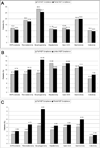Variations in surgical outcomes associated with hospital compliance with safety practices
- PMID: 22261296
- PMCID: PMC3414538
- DOI: 10.1016/j.surg.2011.12.001
Variations in surgical outcomes associated with hospital compliance with safety practices
Abstract
Background: The Leapfrog Group aims to improve patient safety by promoting hospital compliance with National Quality Forum (NQF) safe practices. It is unknown, however, whether implementation of these safety practices improve outcomes after high-risk operations.
Methods: We conducted a cross-sectional analysis of 658 nationwide hospitals that responded to the 2005 Leapfrog Group Hospital Quality & Safety survey. A total of 79,462 patients were identified from Medicare claims data who underwent a pancreatectomy, hepatectomy, esophagectomy, open aortic aneurysm repair, colectomy, or gastrectomy procedure from 2004 through 2006. Random effects logistic regression models were used to estimate the association between hospital compliance with NQF safe practices and risk-adjusted odds of complications, rate of failure to rescue, and mortality after adjusting for patient- and hospital-level confounders.
Results: Of the 658 hospitals that responded to surveys, 41% had fully implemented NQF safe practices and 59% reported partial compliance with these standards. Compared with hospitals with partial NQF compliance, we found evidence that hospitals with full compliance had an increased likelihood of diagnosing a complication after any of the 6 high-risk operations (odds ratio [OR], 1.13; 95% confidence interval [CI], 1.03-1.25), but had a decreased likelihood of failure to rescue (OR, 0.82; 95% CI, 0.71-0.96), and a decreased odds of mortality (OR, 0.80; 95% CI, 0.71-0.91).
Conclusion: Despite having a greater rate of postoperative complications, hospitals fully complying with safe practices were associated with less failure to rescue and decreased mortality after high-risk operations. These results highlight the importance of having hospital systems in place to promote safety and manage postoperative complications.
Copyright © 2012 Mosby, Inc. All rights reserved.
Figures

References
-
- Centers for Medicare & Medicaid Services. [Accessed October 18, 2010];Quality Initiatives - General Information. 2010 Available at: http://www.cms.gov/QualityInitiativesGenInfo/01_overview.asp.
-
- [Accessed: September 23, 2009];Surgical Care Improvement Project Core Measure Set. Available at: www.jointcommission.org/PerformanceMeasurement/PerformanceMeasurement/
-
- National Quality Forum. [Accessed October 20, 2010];NQF in the Quality Landscape. Available at: http://www.qualityforum.org/
-
- [Accessed: September 25, 2010];The Leapfrog Group for Patient Safety. Available at: www.leapfroggroup.org. Available. Accessed January 22,
-
- The Leapfrog Group. [Accessed September 22, 2010];The Leapfrog Safe Practices Score Leap. Available at: http://www.leapfroggroup.org/media/file/FactSheet_SafePractices.pdf.
Publication types
MeSH terms
Grants and funding
LinkOut - more resources
Full Text Sources
Medical

